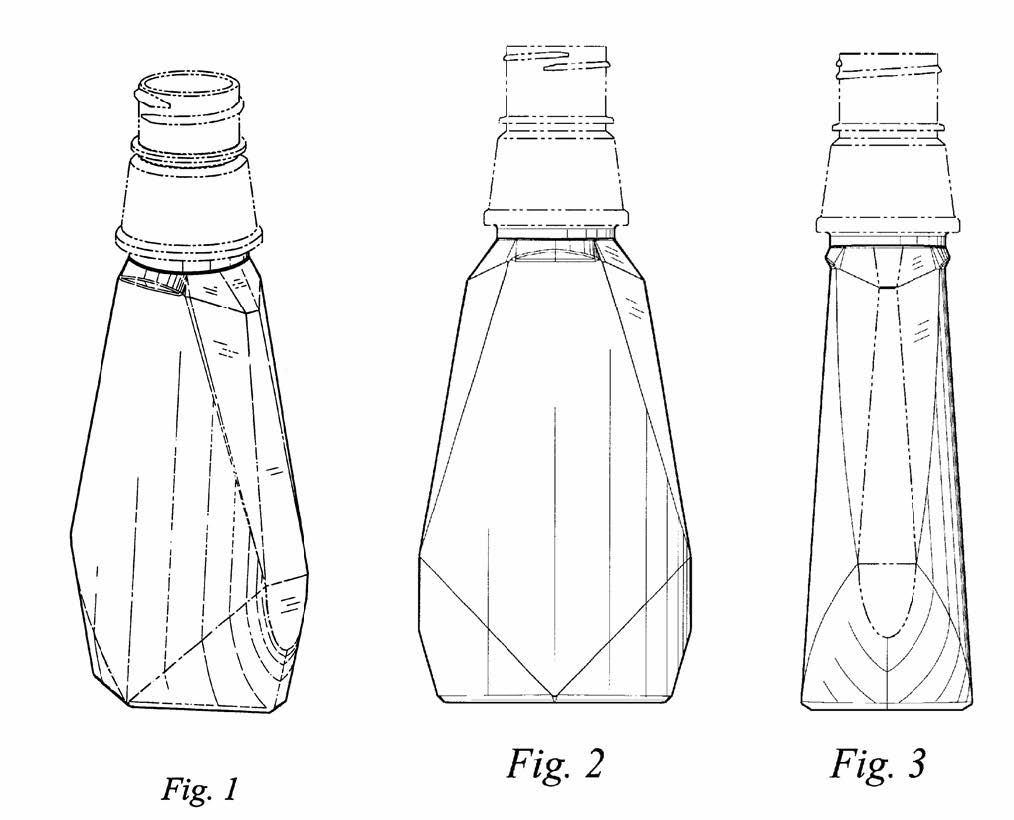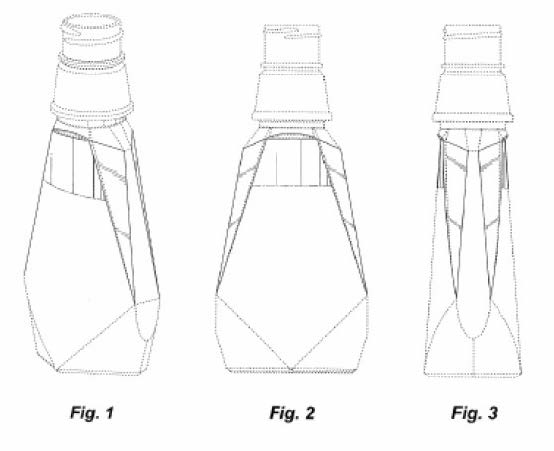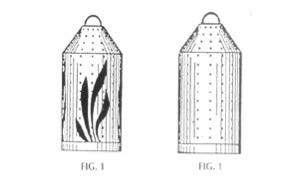CAFC Draws a Line in the Sand as to Adding “Boundary” Lines; PTO recants earlier design practice
| April 3, 2013
In re Owens
March 26, 2013
Panel: Prost, Moore and Wallach. Opinion by Prost.
Summary
Although a practice previously endorsed by the USPTO, the CAFC now holds that the addition of a “boundary” line to a design application constitutes the addition of new matter. Since the parent application gave no indication of one portion of the design being separable from the remainder, the CAFC held that there was no “possession” of the later modification in the original application.
Details
In 2004, Owens filed for a design application on a bottle, as illustrated below:
This application was granted, and eventually issued as D531,515. As a side note, this design can be found in the drugstore—it is used for Crest ProHealth Mouthwash.
During pendency of this application, Owens filed a continuation application, during which the drawings were amended to claim the following modification of the design:
In the continuation drawings, there are several changes. First, there are many solid lines that are changed to broken “environmental” lines. These lines include the lines corresponding to the sections immediately below the cap, as well as to the “V” shaped lines and other lines near the bottom of the bottle. The second change as compared with the parent application drawings was the insertion of a horizontal dot-dash “boundary” line in the upper-center for the front pentagonal face of the bottle.
The first modification—changing solid lines to broken “environmental” lines—was not a problem. However, the Examiner argued that the second change—adding the horizontal dot-dash “boundary” line—amounted to the addition of new matter that was unsupported by the parent application or the initially filed continuation. Specifically, the Examiner argued that this created a new trapezoidal shape not in the original design. In this situation, maintaining priority was essential because the bottle of the original application had been sold more than a year prior to filing the continuation application. Thus, the Examiner concluded that the continuation bottle was obvious in view of the parent bottle. On appeal, the Board agreed.
This must have come as a great surprise to Owens, because the practice of adding a boundary line is endorsed by the USPTO. In particular, MPEP 1503.02 states:
A boundary line may be shown in broken lines if it is not intended to form part of the claimed design. Applicant may choose to define the bounds of a claimed design with broken lines when the boundary does not exist in reality in the article embodying the design. It would be understood that the claimed design extends to the boundary but does not include the boundary. Where no boundary line is shown in a design application as originally filed, but it is clear from the design specification that the boundary of the claimed design is a straight broken line connecting the ends of existing full lines defining the claimed design, applicant may amend the drawing(s) to add a straight broken line connecting the ends of existing full lines defining the claimed subject matter. Any broken line boundary other than a straight broken line may constitute new matter…
Furthermore, as explained in Owens’ brief, an example which was very similar to the bottle in question in this application was given as acceptable practice at a recent USPTO “Design Day” event.
In support of his position, Owens cited to In re Daniels. In that case, the first filed design included a floral design on a container, and the later filed design lacked the floral design:
In Daniels, the CAFC stated that the underlying container without the floral design was “clearly visible in the earlier design application, demonstrating…possession at that time of the later claimed design of that article.” Owens argued that, like in Daniels, his later smaller design was “clearly visible” as a portion of the originally filed larger design. In other words, as summarized by the CAFC, Owens argued “an applicant who has possession of an entire area must likewise possess all parts of the area.”
However, the CAFC distinguished, on the basis that Daniels did not introduce any new unclaimed lines. The CAFC criticized Owens, stating that the reasoning of Daniels does not permit one to subdivide a previously granted design element “in subsequent continuations however he pleases” by adding new boundary lines. Specifically, the CAFC stated that: “the question for written description purposes is whether a skilled artisan would recognize upon reading the parent’s disclosure that the trapezoidal top portion of the front panel might be claimed separately from the remainder of that area”, citing Ariad v. Eli Lilly (emphasis added). In other words, the CAFC seems concerned that the original design could be subdivided in nearly infinite ways using boundary lines. As such, the CAFC ruled that the continuation drawings do indeed include new matter, and thus are not entitled to priority.
Finally, as noted above, the USPTO has previously endorsed the addition of boundary lines in continuation applications, a seemingly inconsistent position. Citing to the amicus brief, the CAFC pointed out an example of this, which is illustrated below:
The CAFC refrained from specifically commenting on this design, but took the unusual step of giving specific advice to future applicants:
In our view, the best advice for future applicants was presented in the PTO’s brief, which argued that unclaimed boundary lines typically should satisfy the written description requirement only if they make explicit a boundary that already exists, but was unclaimed, in the original disclosure. Although counsel for the PTO conceded at oral argument that he could not reconcile all past allowances under this standard, he maintained that all future applications will be evaluated according to it.
Takeaway
As is clear from the above, it appears that adding a “boundary” line where no line was present in the application as filed will be regarded as adding new matter. As such, Applicants should presume that they are limited to changing broken lines to solid lines, and vice versa. For this reason, prior to filing a design application, the Applicants should confer with their attorney and brainstorm all possible variations prior to filing. Although this may increase upfront costs, it will help to keep an Applicant’s options open in the future. Additionally, an owner of a design patent based on the USPTO’s now abandoned practice of permitting addition of boundary lines may consider filing a reissue application in some situations.
Tags: design > design patents > new matter > possession > written description






